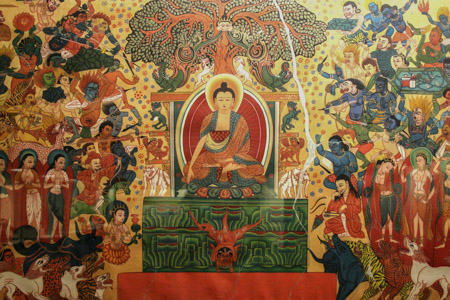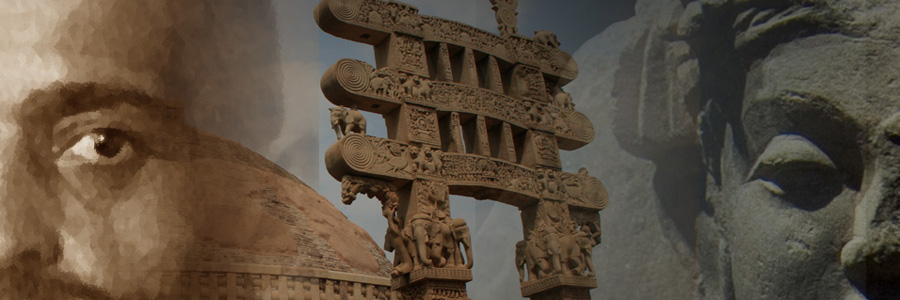“Then Siddhartha, looking back on the city, exclaimed, ‘Until I have seen the other shore of birth and death, I will never again enter my Father’s city!” – Buddhacarita
 In our previous post on The Great Departure, we followed Siddhartha’s escape from the prison of his father’s palace. We looked at a Buddhist relief showing the moment of Siddhartha’s liberation and noted that the physical penetration of the artwork into a new dimension, reflected Siddhartha’s awakening–his penetration into a new dimension of consciousness.
In our previous post on The Great Departure, we followed Siddhartha’s escape from the prison of his father’s palace. We looked at a Buddhist relief showing the moment of Siddhartha’s liberation and noted that the physical penetration of the artwork into a new dimension, reflected Siddhartha’s awakening–his penetration into a new dimension of consciousness.
Whilst Siddhartha is yet at the threshold of awakening, a new and meaningful element enters the narrative of his story, one that will beset him throughout the next phases of his evolution. This element is Māra, the opponent of liberation.
As the young prince is on the cusp of departure, he hears a voice urging him to reconsider:
“Go not forth sir!” said Mara with the intention of stopping the Bodisattva: “In seven days from now you will become ruler over the four continents and the two thousand adjacent isles. Stop, O my lord!” – Nidankatha
 Māra personifies opposition. He is portrayed in Buddhist art as a mean-spirited general riding an elephant and leading an army of chaotic devils. These represent the emotions, thoughts and sensations that hinder awakening.
Māra personifies opposition. He is portrayed in Buddhist art as a mean-spirited general riding an elephant and leading an army of chaotic devils. These represent the emotions, thoughts and sensations that hinder awakening.
Of particular interest is the timing of Māra’s appearance: so long as the prince was immersed in palatial luxury, Māra remained behind the scenes, but now that he is about to depart, Māra appears in person to persuade Siddhartha to return.
Conscious effort attracts opposition.
“As soon as a man awakens for a moment and opens his eyes, all the forces that caused him to fall asleep begin to act upon him with tenfold energy and he immediately falls asleep again, very often dreaming that he is awake.” – George Gurdjieff
 This episode of The Great Departure teaches us to expect an increase in internal opposition at the moment of awakening. In other words, in order to prolong consciousness, our efforts must increase.
This episode of The Great Departure teaches us to expect an increase in internal opposition at the moment of awakening. In other words, in order to prolong consciousness, our efforts must increase.
The prince disregards Māra’s temptations and proceeds to leave his father’s palace. Māra will now jealously follow the development of Siddhartha, waiting for an opportunity to trip him back to prison. In the words of the Buddhist legend: “Then the Tempter followed him, ever watching for some slip, as closely as a shadow which never leaves its object.”
Māra’s opposition will steadily increase through each step of Buddha’s journey and will culminate in the chapter of Enlightenment (which will be examined in a future post).
For this month, I invite our readers and writers to experiment: let us repeat an exercise Peter Ouspensky used in his introductory meetings:
“Take a watch and look at the second hand, trying to be aware of yourself, and concentrating on the thought, ‘I am Peter Ouspensky,’ ‘I am now here.’ Try not to think about anything else, simply follow the movements of the second hand and be aware of yourself, your name, your existence and the place where you are. Keep all other thoughts away. You will, if you are persistent, be able to do this for two minutes. This is the limit of your consciousness.” – Peter Ouspensky
What do you find when you try to be present for two minutes uninterruptedly? Can you see Māra increasing his resistance? Can you catch the emotions, thoughts and sensations of his army before they hinder you?
